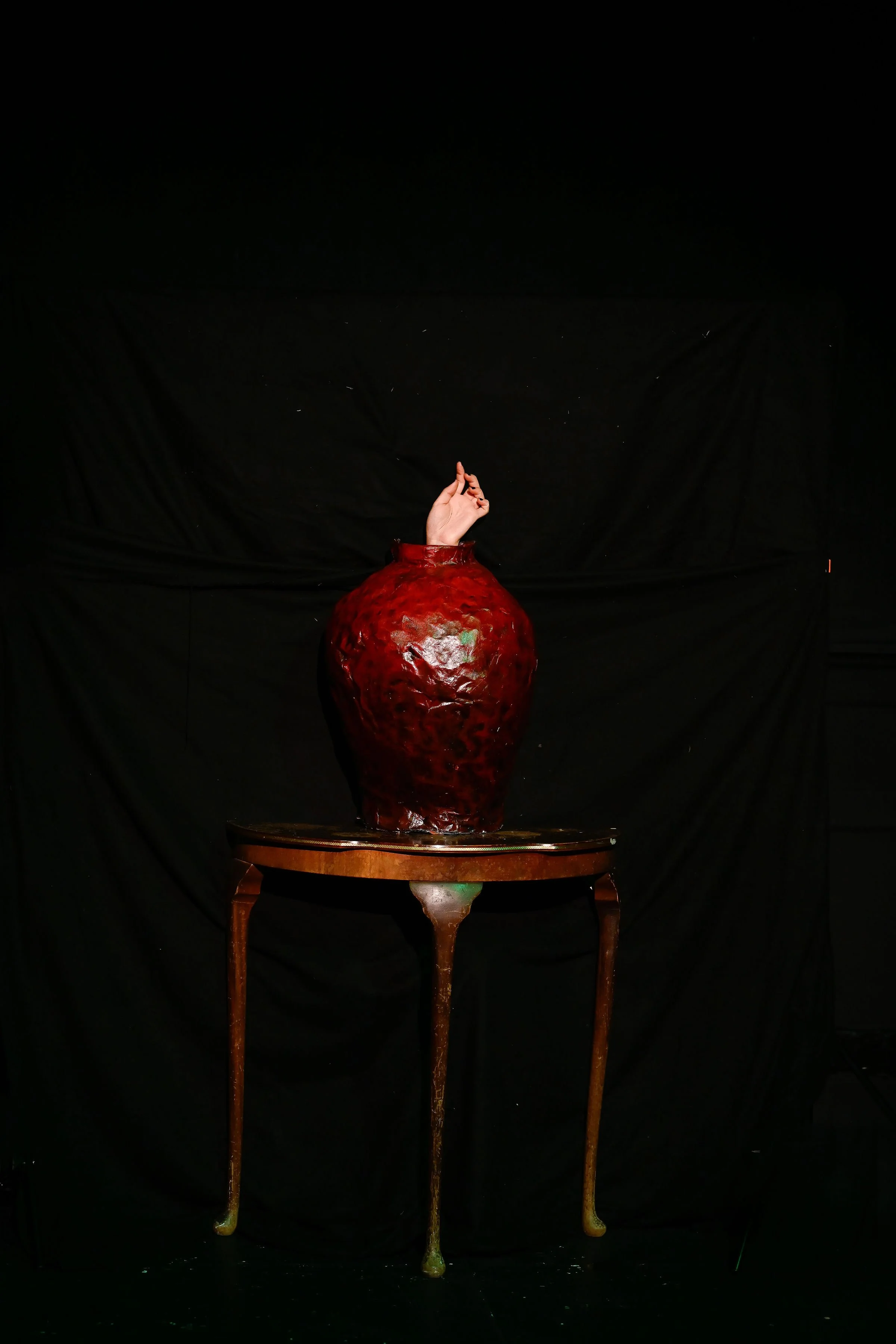Runxuan Yang: Interview for Staging Decadence
Runxuan Yang is a Chinese-born, asexual performance artist working across scenography, drag, movement, and visual storytelling. Her work weaves together personal and political mythologies of diaspora, gendered violence, and embodied memory, often drawing from Chinese and Southeast Asian folklores, drag spectacle, feminist freakery, and stand-up to craft fragmented, haunted performance scores. Her practice resists normative erotic spectacle, creating space for alternative forms of relation, desire, and presence.
Runxuan’s recent performance persona May Kway emerges from the grotesque entrapment of beauty: a vase-bodied showgirl who lip-syncs through orientalised glamour before breaking into bloodied monstrosity. Mixing elements of cabaret, visual installation, and horror drag, May Kway explores the collapse of ornamental femininity and the politics of looking. Her performances stage not only the decay of exoticised spectacle, but also the discomfort of spectatorship itself. Informed by theories of decadence, queer aesthetics, and diasporic hauntings, her work questions the cost of surviving glamour and the gaze.
Runxuan’s work has been presented across fringe festivals, drag and cabaret nights, and experimental performance events in London, including Camden Fringe, Peckham Fringe, Soho Theatre Labs, Riverside Studios, Hoxton Hall, Hundred Years Gallery, the Old Nun’s Head, and the Ritzy.
Fig. 1: Runxuan Yang, Vase Girl at Fresh Meat, Old Nunshead, London, 7 March 2025. Photo: Jennifer Forward-Hayter.
Adam Alston: Vase Girl has been in development since July 2023, sharing various iterations over the past two years. It’s an incredibly layered piece. Could you tell us about some of the influences that you reference?
Runxuan Yang: It's rooted in a song by Chen Gexin and first recorded by Yao Lee in 1940 called ‘Rose, Rose, I Love You’ (玫瑰玫瑰我愛你). There were subsequent Western versions by Frankie Lane (1951), Petula Clark (1951), and others. Clark gave the song a new title: ‘May Kway’, inspired by the anglicised sound of the Mandarin lyrics ‘méigui méigui [rose, rose]’. Later on I also came across the 1984 documentary Ricochet, about David Bowie, which looks at a tour he’d undertaken in Asia. There’s a short clip of him humming a little bit of the song in a taxi. Later on he’s at a dinner party on a boat with a group of women from Hong Kong. The women are discussing something very serious about the UK returning Hong Kong to China in 1997 – they’re discussing this in the 1980s – and describing how the infrastructure is falling apart, and how worried they all are, but then Bowie interrupts and asks them to sing ‘May Kway’ for them. The English version he’s referencing is also a racist version of the lyrics. The song has spread internationally, but not really the Chinese original. I found that interesting and decided to use adapted versions in my act.
I’ve been exploring the act now for a very long time, developing the character May Kway as a kind of ‘vase girl’. There’s both truth and fiction in this act. Obviously May Kway is a character, but the piece is also referencing an actual freak show fad that many Chinese people will recognise. Incidentally I was also reading Rosemarie Garland-Thompson at the time – her work on staring and freakshows – but it’s the ‘vase girl’ act in Chinese travelling circuses that was particularly important for me, which would go around small towns in China catering for people wanting excitement. One of the acts would give the appearance of a girl’s body having been trapped in a vase when she was very young, with the head growing ‘normally’ out of the top. It was a magic trick of course. It’s an optical illusion. The girl would kneel behind hidden walls, and clever use of mirrors gives the effect of her body being trapped in the vase. People would pay to see the vase girl, who would smile sweetly and perhaps rock a bit from side to side. The circus host would be the one talking throughout, not the girl, unless you paid a bit more money to hear her sing. The host would tell you how fragile and delicate she was, stressing how tired she gets and that she could only perform for short stretches at a time – itself a ruse to get more people to pay and stare.
Fig. 2: Runxuan Yang, still from the Vase Girl, shadow theatre animation at Terror Nova, Goldsmiths, University of London, 29 June 2023. Animation by Runxuan Yang, with camera assistance from Faye Yan.
AA: This is essential context. When I’ve mentioned this piece to friends and colleagues, very often the first thing they’ll say is, ‘oh, well that’s a riff on Beckett’s Play (1963), right?’ It was one of the references that first came to mind for me, too, but it’s a world away from the vase girl act you’ve just described, where misogyny and the exploitation of the performer is foregrounded.
RY: Yes, the first couple of times I was performing this in London, people would come to me and say just this! It was all Beckett… I was completely lost!
AA: It’s also a very refined piece. It puts me in mind of Anne Anlin Cheng’s brilliant book Ornamentalism (2018), and the cultural politics of what it means to designate something as ‘refined’: a term that can be at once both a highly valued characteristic of something, but also a quality that can be caught within an orientalist gaze that fixates on an idealised view of eastern art and culture as being too refined, refined to the point of corruption.
RY: When you first mentioned Cheng’s Ornamentalism to me I found it really useful. I conceived and first performed the piece in July 2023. I’d made a longer version in August 2024, too, which was 40 minutes, although I wasn’t quite satisfied with it. Something got lost. It's much better as a cabaret act, as it holds the piece’s absurdity and makes the whole thing more alive and unstable.
Fig. 3: Runxuan Yang, Make Way for Rosel at Hatch & Scratch, Peckham Fringe, Golden Goose Theatre, London, 2 June 2024. Photo: East Photography.
From October 2024 I carried on developing it as a cabaret piece, which is when I finally discovered decadence and ornamentalism. Before that, I looked at some research addressing foot binding, mainly by Dorothy Ko. She focuses on women’s actual corporeal experience of pain, which distinguishes her from previous authors on foot binding where that isn’t the case and it’s approached in a more abstract way. The case against foot binding was strongly linked to men explaining why it made the nation appear ‘disgraceful’. But unbinding the foot can also be painful for women. It’s not as simple as saying that foot binding is bad, and anti-foot binding is good. The research on foot binding got me thinking about this paradoxical way of being for women, in which pain and agency become tangled. But it was Ornamentalism that helped me identify this struggle of building personhood through objectification. That’s when I could piece everything together – from historical pain, to current feminist debates in China, to my own experience – and finally make sense of what I was doing with this piece.
AA: You mentioned decadence then, too. Could you tell us more about what you found useful about decadence as a reference or frame?
RY: Every time I develop the piece I refine it, but in doing so there’s also a sense of it falling apart, at least for me. A lot of what’s in there doesn’t get communicated to audiences in London, so that’s what I mean about failure or it falling apart being built into the piece. I realised that the audience not fully ‘getting it’ is part of the performance. That’s where the decadence comes in: not just in the visual excess, but in how the act breaks down expectations embedded in spectatorship itself. I try and refine and polish it, but it just emphasises the issues with communication. I ended up preferring going with the flow and just letting it fall apart.
AA: Decadence as methodology, then? I’m also interested in how you’re connecting decadence, orientalism, and ornamentalism. A generalised and exoticised ‘East’ – silks and opium, for instance – is abundant in decadent art and literature. What I find refreshing about your practise is how it acknowledges complex histories regarding how the east has been exoticized in art and popular culture – including decadent art and literature – whilst also still being itself ‘decadent’.
RY: I don’t think about decadence and orientalism as being so closely linked in my practice. It feels really natural for me to approach orientalism, because it’s part of my experience as a Chinese person living in the UK. Of course, orientalism is also a powerful troupe that I can turn to my advantage, as it gives me tools to play with the audience’s expectations. With decadence, it’s more about working with decay in acts of rebellion – although ornamentalism did lead me back to decadence. It’s there in the structure, too. It begins with the wonderfully beautiful ‘surface’ of the vase girl, although it’s not a lasting beauty. It starts to crack, and a monstrous and ghostly side of her comes through.
Fig. 4: Runxuan Yang, Vase Girl at Fresh Meat, Old Nunshead, London, 7 March 2025. Photo: Jennifer Forward-Hayter.
AA: How does this relate to the materials that you're working with? In this piece the vase is front and centre, but in some iterations you also design these brilliant, if disturbing, costumes that look like highly refined entrails. They make May Kway reminiscent of an Anatomical Venus, in which the abject and visceral is made unsettlingly beautiful, and thoroughly bound up with the grim objectification of the female body.
RY: Even though the garment looks like it’s decaying, it’s also beautiful. I’m also referencing flying head myths and legends in East Asian and Southeast Asian cultures [for instance, the Krasue (กระสือ) in Thailand, the Rokurokubi (ろくろ首, 轆轤首) in Japan, the Luotoushi (落头氏) in China, or the Penanggalan in Malaysia], in which cursed women return in a horrifying form with only their head preserved intact, dangling bloody entrails from the neck down. I wanted to turn my vase girl into a flying head ghost. I’m playing with reality and fiction here. The ‘real’ body that the vase is meant to hide is turned into a fabricated and bloody garment-body-part. She’s trapped within ornamentalism, but also breaking out of it. The contrast between the hard, polished vase, and the raw, fleshy organ-dress, shows a female ghost who doesn’t fit normative expectations. She’s both too much, and not enough: a restless figure of diaspora and revenge.
Fig. 5: Runxuan Yang, Vase Girl at Fresh Meat, Old Nunshead, London, 7 March 2025. Photo: Jennifer Forward-Hayter.
AA: And what's next for you? Where do you want to take your work in garment design and cabaret?
RY: Well, I have a lot of versions of this piece, and also some stand-up comedy iterations. I’m thinking of it as a body of acts, with the character in different moods depending on the act. I’m enjoying the restlessness, and its queerness.





